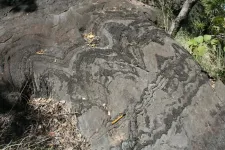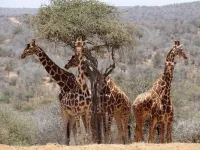(Press-News.org) Analysis of fossilised rocks known as stromatolites from more than two-and-a-half billion years ago has provided new insights into the conditions on Earth before the evolution of oxygen.
Led by Northumbria University researcher, Dr Ashley Martin, an international team with expertise in geology, microbiology, and geochemistry, worked in partnership to investigate nitrogen cycling patterns within ancient stromatolites, preserved in southern Zimbabwe.
Nitrogen is vital for all life on Earth but must first be converted into useable, bioavailable, forms as it passes through the atmosphere, soil, plants and animals in the nitrogen cycle.
The team believe the unusual nitrogen isotope patterns found in Zimbabwe can offer new understandings of the mechanisms at play in Earth’s early marine environment before the Great Oxidation Event, which occurred between 2.5 to 2.3 billion years ago. This event, which was likely caused by the evolution of photosynthesis, is a major milestone in Earth's history, and saw the first rise of oxygen concentration in Earth’s atmosphere.
Scientists have long debated about the biological and chemical conditions that led to the Great Oxidation Event and little is known about nitrogen cycles before it took place. At this point in time, the early Earth would have looked very different from today, with most continents still submerged beneath a great ocean that covered the planet.
Dr Martin, from the Department of Geography and Environmental Sciences at Northumbria University, said: “There are two key nutrients that control productivity in the oceans on geological timescales – nitrogen and phosphorus. Together they ultimately control the productivity of marine life.
“Our study reveals high nitrogen isotope values in 2.75 billion-year-old shallow water stromatolites, and lower nitrogen values in deeper marine sediments. This suggests that ammonium, which is nitrogen in its reduced form, accumulated in the deep waters and was brought into shallow waters by upwelling – the movement of deep nutrient-rich water towards the surface of the ocean.
“A large ammonium reservoir would have been very beneficial for early life, providing the nitrogen source needed for biological processes to occur. These conditions, likely in an ocean depleted of dissolved oxygen with a strong volcanic or hydrothermal influence, would have helped to support microbial growth, potentially spurring biological innovations and paving the way for the Great Oxidation Event.”
A paper published in the prestigious scientific journal, Nature Communications, outlines the findings of the research team, which includes experts from the University of St Andrews; the University of Kaiserslautern-Landau in Germany; Leibniz University, Hannover; the Max Planck Institute for Chemistry in Germany and the University of Johannesburg in South Africa.
Dr Eva Stüeken from the University of St Andrews explained: “We have long been puzzled by the unusual nitrogen isotope values in these rocks. Our new findings suggest a strong linkage to hydrothermal nutrient recycling, meaning that early life may in part have been fuelled by volcanic activity.”
Professor Axel Hofmann from the University of Johannesburg added: “Volcanism was exceptionally active 2.75-billion-years ago and left a lasting impact in the evolution of life at that time. Rocks in Zimbabwe preserve a remarkable record of this time interval.”
The proposal that in some areas of the world, large quantities of bioavailable nitrogen in the form of ammonium may have accumulated in the ancient oceans due to volcanic activity and fuelled the development of life, is supported by an earlier study from Dr Martin, Dr Stüeken and Dr Michelle Gehringer from University of Kaiserslautern-Landau. The results were published in the journal Geology.
Dr Martin and another co-author of the Nature Communications paper, Dr Monika Markowska, are members of Northumbria University’s Environmental Monitoring and Reconstruction (EnMaR) research group which studies modern and ancient environments, from the tropics to the polar regions, and seeks to answer fundamental global questions about climate and the environment.
FURTHER INFORMATION:
Visit the Northumbria University Research Portal to find out more about Dr Ashley Martin’s work.
Anomalous δ15N values in the Neoarchean associated with an abundant supply of hydrothermal ammonium was published in Nature Communications.
DOI: https://doi.org/10.1038/s41467-025-57091-3
END
Research provides new detail on the impact of volcanic activity on early marine life
Analysis of fossilised rocks known as stromatolites from more than two-and-a-half billion years ago has provided new insights into the conditions on Earth before the evolution of oxygen. Led by Northumbria University researcher, Dr Ashley Martin, an inter
2025-02-24
ELSE PRESS RELEASES FROM THIS DATE:
NCSA awarded funding to continue AI-focused NSF REU program
2025-02-24
The National Center for Supercomputing Applications received funding from the U.S. National Science Foundation (NSF) to renew its annual Research Experience for Undergraduates (REU) program, the Future of Discovery: Training Students to Build and Apply Open Source Machine Learning Models and Tools (FoDOMMaT).
Housed in NCSA’s Center for Artificial Intelligence Innovation (CAII), the 10-week on-site experience brings about 10 undergraduate students each year from a variety of academic backgrounds to the University of Illinois Urbana-Champaign campus to engage in cutting-edge machine learning and deep learning projects, developing ...
New USF study identifies urgent need to protect coastal marine ecosystems
2025-02-24
TAMPA, Fla. (Embargoed until Feb. 24, 2025) – A new study led by the University of South Florida highlights the urgent need to protect marine ecosystems in shallow water near the shore – an area that many beachgoers don’t realize is highly important to fish populations. Known as tidal flats, these coastal waters are critical to global seafood supplies, local economies and overall marine health.
The findings from a team of interdisciplinary marine experts, “Habitat management and restoration as missing ...
Mega-iceberg from Antarctica on collision course with South Georgia: harbinger of things to come?
2025-02-24
It is no strange sight to see icebergs break off of the Antarctic ice cap and drift away, like the gigantic sheet of ice that is currently heading for the island of South Georgia. But climate change is making it happen more frequently, with ever-larger icebergs in the waters around Antarctica. Researchers from Utrecht University are studying the routes that icebergs followed during geological periods of rapid ice cap deterioration, such as the ends of ice ages. That provides crucial information about the effect of melting icebergs on the oceans, and its consequences for the future. In the process, ...
Beneath the bog: FAU awarded $1.3 million to track carbon and gas flow in peatlands
2025-02-24
Peatlands, a type of wetland found around the globe at all latitudes – from the Arctic to the tropics – are important ecosystems that store vast amounts of carbon. In fact, peatlands hold about one-third of the world’s soil carbon, despite covering only about 3% of the Earth’s land surface. When peatlands are disturbed or altered, they can release that carbon back into the atmosphere as greenhouse gases like methane. Peatlands are valuable ecosystems both for their biodiversity and for their role in regulating climate.
Researchers ...
ETRI to collaborate on semiconductor technology with US Argonne National Laboratory
2025-02-24
Korean researchers will begin collaborating in earnest with the U.S. Department of Energy’s (DOE) Argonne National Laboratory (ANL) on semiconductor technology research.
Electronics and Telecommunications Research Institute (ETRI) announced on Jan. 6 (local time) that it has agreed to establish a mutual cooperation system to develop semiconductor technologies with Argonne National Laboratory in Illinois, USA.
ETRI has possessed the technology to develop and manufacture silicon detectors for high-energy particle detectors since the early 2000s ...
Unexpected discoveries in study of giraffe gut flora
2025-02-24
The gut bacteria of giraffes are not primarily determined by what they eat, but by the species they belong to. This is shown in a new study from Uppsala University and Brown University in which researchers have analysed the link between diet and gut flora in three giraffe species in Kenya. The study also provides new knowledge that can help secure the food supply of endangered giraffe species.
In a new study published in Global Ecology and Conservation, researchers have analysed the relationship between the diet and microbiome, or gut flora, of giraffes in Kenya. By sequencing plant and bacterial DNA from faecal samples, they were able to investigate both the bacterial composition ...
Not all heart inflammation is the same
2025-02-24
A group of Berlin researchers in collaboration with international scientists have found differences in heart inflammation caused by COVID-19, anti-COVID-19 vaccination, and non-COVID-19 myocarditis. The find paves the way for more personalized therapies, they report in “Nature Cardiovascular Research.”
Heart inflammation, or myocarditis, differs depending on its cause. A collaborative study led by Dr. Henrike Maatz, a scientist in the Genetics and Genomics of Cardiovascular Diseases lab of Professor Norbert Hübner at the Max Delbrück ...
New home-based intervention could reduce emergency hospital admissions for older people
2025-02-24
A new service aimed at supporting older people who are starting to become frail, could reduce emergency hospital admissions by more than a third and save the NHS money, finds a new study led by UCL researchers.
The results from the clinical trial, published in The Lancet Healthy Longevity and funded by the National Institute for Health and Care Research (NIHR), evaluated the effect and cost-effectiveness of a new service, consisting of six personalised home-based visits from a support worker, tailored to each person to identify what they need to stay well and independent.
Interventions ...
Can exercise help colon cancer survivors live as long as matched individuals in the general population?
2025-02-24
Physical activity may help colon cancer survivors achieve long-term survival rates similar to those of people in the general population, according to a recent study published by Wiley online in CANCER, a peer-reviewed journal of the American Cancer Society.
Individuals with colon cancer face higher rates of premature mortality than people in the general population with matched characteristics such as age and sex. To assess whether exercise might reduce this disparity, investigators analyzed data from two posttreatment trials in patients with stage 3 colon cancer, with a total of 2,875 patients who self-reported ...
Unlicensed retailers provide youths with easy access to cannabis in New York City
2025-02-24
NEW YORK, NY (Feb. 24, 2025)--A new study, led by researchers at Columbia University, suggests it is easy for youths to purchase cannabis from unlicensed dispensaries in New York City, despite state laws that bar access to recreational cannabis to those under age 21.
“Regulation to restrict access in this age group is based on evidence that cannabis affects working memory, brain development, and increases addiction risk when used at an early age,” says Ryan Sultán , an assistant professor ...
LAST 30 PRESS RELEASES:
New study shows how the spleen helps the immune system accept a transplant
New Mayo Clinic study advances personalized prostate cancer education with an EHR-integrated AI agent
Researchers identify novel therapeutic target to improve recovery after nerve injury
Microbes in breast milk help populate infant gut microbiomes
Reprogramming immunity to rewrite the story of Type 1 diabetes
New tool narrows the search for ideal material structures
Artificial saliva containing sugarcane protein helps protect the teeth of patients with head and neck cancer
Understanding the role of linear ubiquitination in T-tubule biogenesis
Researchers identify urban atmosphere as primary reservoir of microplastics
World’s oldest arrow poison – 60,000-year-old traces reveal early advanced hunting techniques
Bristol scientists discover early sponges were soft
New study uncovers how rice viruses manipulate plant defenses to protect insect vectors
NSF–DOE Vera C. Rubin Observatory spots record-breaking asteroid in pre-survey observations
Ribosomal engineering creates “super-probiotic” bacteria
This self-powered eye tracker harnesses energy from blinking and is as comfortable as everyday glasses
Adverse prenatal exposures linked to higher rates of mental health issues, brain changes in adolescents
Restoring mitochondria shows promise for treating chronic nerve pain
Nature study identifies a molecular switch that controls transitions between single-celled and multicellular forms
USU chemists' CRISPR discovery could lead to single diagnostic test for COVID, flu, RSV
Early hominins from Morocco reveal an African lineage near the root of Homo sapiens
Small chimps, big risks: What chimps show us about our own behavior
We finally know how the most common types of planets are created
Thirty-year risk of cardiovascular disease among healthy women according to clinical thresholds of lipoprotein(a)
Yoga for opioid withdrawal and autonomic regulation
Gene therapy ‘switch’ may offer non-addictive pain relief
Study shows your genes determine how fast your DNA mutates with age
Common brain parasite can infect your immune cells. Here's why that's probably OK
International experts connect infections and aging through cellular senescence
An AI–DFT integrated framework accelerates materials discovery and design
Twist to reshape, shift to transform: Bilayer structure enables multifunctional imaging
[Press-News.org] Research provides new detail on the impact of volcanic activity on early marine lifeAnalysis of fossilised rocks known as stromatolites from more than two-and-a-half billion years ago has provided new insights into the conditions on Earth before the evolution of oxygen. Led by Northumbria University researcher, Dr Ashley Martin, an inter





